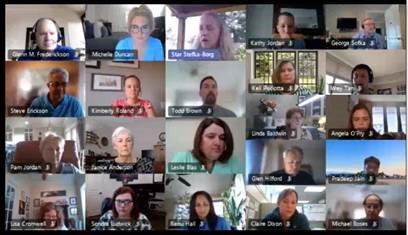26 Aug One small step for tech, one giant leap for teams
“Renu, what’s most important is that we can all see each other. Our conferencing tools must support high-quality video feeds.”
That was our CEO Steve Erickson’s most important requirement when we began our evaluation and selection of communication and web-conferencing platforms in March of this year.
Why? I thought to myself, while dutifully noting it down. I was certain we could check that ‘high-quality video feed’ box off with any platform we picked. But I for one, did not plan to ever turn on my webcam. While always available, I’ve never used my camera on a conference call with my coworkers in all my many previous years of remote collaboration. We’ve never needed to. We get on calls, we share content, collaborate, take notes, make decisions, and then we get off. Sure, I realize that 75% of communication is non-verbal, but that’s only when you don’t know your audience, such as a prospect or customer. As colleagues, we already know each other well. Even with this new work-from-home strategy, video was going to be a non-issue… so I thought.
The timing of this initiative, of course, would change everything.
Within a few weeks of evaluation, we had picked our platform: Microsoft Teams. Its chats, calls, and meetings features far surpassed the capabilities of our existing Skype for Business platform, and was the natural successor. It completely integrated with our collaboration and content platform Office 365, and with zero additional licensing costs unlike other comparable products, leveraging what we already owned was the obvious business decision.
As we rolled out Teams for meetings, chats, and calls to all employees across the country, a strange and unexpected thing began to happen in the training sessions. People started to turn their cameras on. They showcased their custom backgrounds. They embraced the silly gifs, engaged with raised hands, and comments flowed in the side bar. With each new video chat, there was a growing sense of camaraderie and community.
The timing of our rollout, coinciding with Teams’ support for video feeds growing from four to nine to forty-nine in the big gallery view could not have been better. Teams did more than create a common platform for us to communicate. It connected us. I met several of my colleagues in other cities for the very first time after months or even years of working together, and we literally cheered when we finally met face to face!
Why had we never done this before?
While I thought I knew my co-located team mates pretty well, the video feeds opened windows into lives and personalities that we had never shared before: adorable kids vying for attention, eager pups chewing on squeaky toys, cats sunning on window sills, plants stacked on shelves, spouses whose names we’d only heard till now. We saw glimpses of hobbies, favorite movie posters, photos of special people, and prized memorabilia. There was so much more to knowing one another than I could have guessed.
Meetings are notoriously unpopular in typical business culture, but we were hearing confessions from even the most stalwart introverts that they now looked forward to the Teams meetings to break the monotony and isolation. The topics almost didn’t matter.
“I’ve never felt closer to you folks in Houston, than in the previous 13 years we’ve worked together.” That comment from a close colleague summarized the unexpected sense of unity and community that the novel Coronavirus had started, but our Teams video collaboration platform brought home.
While the pandemic has physically separated us, and socially isolated us, it also erased the miles between us. Oregon, Arizona, New Mexico, Colorado, Texas, Louisiana, Ohio, and Tennessee – we are now equally spaced and side by side on the screen; we are literally on the same page.
I do all my internal meetings with camera on now. Simply listening to voices and imagining faces is no longer enough.
You were right, Steve Erickson. What’s most important is that we can see each other. Thank you for focusing on the things that matter.
While the pandemic has physically separated us, and socially isolated us, it also erased the miles between us. Oregon, Arizona, New Mexico, Colorado, Texas, Louisiana, Ohio, and Tennessee – we are now equally spaced and side by side on the screen; we are literally on the same page.
I do all my internal meetings with camera on now. Simply listening to voices and imagining faces is no longer enough.
You were right, Steve Erickson. What’s most important is that we can see each other. Thank you for focusing on the things that matter.




